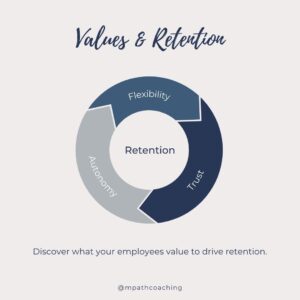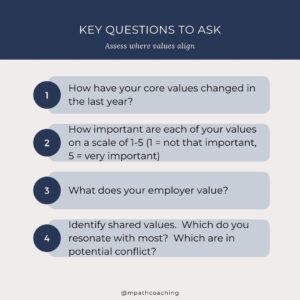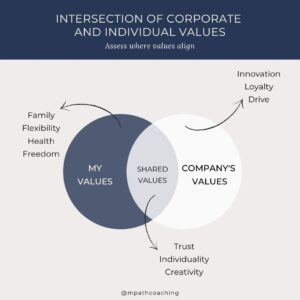Many of us are reflecting on how our values align, or do not align, with our jobs. As we return to work, how can employers create a more seamless experience and maximize retention in a changing workplace?
Reverting to pre-pandemic work environments and leadership models may contribute to attrition and trivialize the lessons learned. Reimagine work by inviting employees to the conversation, and ask your employees what matters most to them. Once you gain a deeper understanding of what they value, you can plan more effective retention and engagement strategies.
Communication and Transparency
Whether return to work is done as a phased or ‘big bang’ approach, communication and transparency can go a long way to minimize anxiety and dispel myths. This includes cascading communication about safety measures, expectations, and available resources. As you develop your communication plan, it can be helpful to:
-
- Know your why. Examine why returning to the office is important and how it benefits employees
- Create a platform where employees can voice their concerns, ask questions, and receive regular updates for additional clarity
- Prepare leaders to have difficult conversations with their teams by providing coaching, resources, and support
Flexibility, Autonomy and Trust
The key is to revisit culture and values and modernize them for today’s environment. Employees may want flexibility customized to their unique situations. While it can be challenging to accommodate everyone, understanding different perspectives can contribute to win-win outcomes.
Rather than going into the office every day for example, teams can schedule in-person collaboration days. While in the office, maximize collaboration time. This does not mean filling calendars with back-to-back meetings; it means allowing teams to brainstorm, build camaraderie, and get work done.
Flexibility, autonomy, and trust can drive employee engagement and retention. Autonomy provides the freedom for employees to get work done without micromanagement, and trust acts as a critical underpinning to keep autonomy alive.

For employees who return to the office fulltime, leaders will need to shift their expectations, such as factoring in commute times and potential productivity adjustments.
Mental and Emotional Wellbeing
During August 2020 to February 2021, the percentage of adults with symptoms of an anxiety or a depressive disorder increased from 36.4% to 41.5%, according to the CDC. Consider mental and emotional impacts to the workforce, practice patience and empathy, and provide resources for support. This may include internal initiatives to enhance wellbeing and external resources for specialized support.
As employees gain a deeper understanding of their values, they may develop a heightened sensitivity to toxic environments. Make necessary changes to improve the culture. From a structural standpoint, look at ways to improve efficiency and collaboration. Optimize processes, prioritize ruthlessly, and create room to breathe.
Beyond Belonging
As Diversity, Equity, Inclusion, and Belonging (DEIB) jumps to the forefront, companies are grappling with ways to navigate this terrain. Microaggressions can occur anywhere, even within marginalized groups. This introduces additional layers of complexity to DEIB efforts. To amplify psychological safety, co-create a new culture with underrepresented groups. Allow space to “discuss the undiscussable” through candid conversations and feedback.
Beyond diversity training, which only skims the surface and potentially introduces more bias by highlighting differences, consider long-term programs and cultural overhauls. Business Resource Groups (BRGs) can be helpful, provided employees identify with a particular group. Those who do not may feel left out, so check sentiment at the individual level. Strive to make DEIB a company-wide rather than HR-only priority.
DEIB is a Collective Effort
In addition, the Chief Diversity Officer (CDO) role should be defined and elevated, with a seat at the table to influence decision-making. Other C-suite executives should not be afraid to engage in difficult conversations with the CDO. Avoid offloading the DEIB responsibility to the CDO, as it needs to be a collective effort.
Systemic changes take time, effort, and empathy. The process requires vulnerability and courage, as we learn how to safely communicate at work and uncover our own biases.
Key Considerations for Individuals as they Return to Work
Burnout levels have increased over the last year, with more than half (52%) of respondents feeling burned out, according to a report by Indeed. This makes sense given global disruption, upheaval, and trauma.
While work-life balance or integration can be a goal, work-life separation can be a more radical approach to minimize burnout. This includes taking inventory of your energy levels and maintaining your boundaries. Learn your triggers and recognize what you can and cannot control.
When undergoing any transition, evaluate what matters most to you. Be compassionate with yourself as you navigate through uncertainty and return to work. Revisit your values and how they might have shifted over time.
Below are some key questions to ask as you adapt to changes in the workplace.


Final Thoughts
As we reconnect to our values, we can find alignment and make pivotal changes at the individual and organizational level. We can look for ways to connect to something greater – to self, purpose, each other, and our work.

Manisha Dhawan, Founder and CEO of MPath Coaching, is a certified professional coach (CPC), MBA and management consultant with 2 decades of experience leading digital innovation and change management initiatives across multiple industries. As a design thinking specialist and lifelong learner, Manisha is passionate about empowering executives to advance leadership skills, maximize team potential, and drive innovation forward. In addition to corporate coaching, Manisha works with professionals on career strategy and human skills development.

